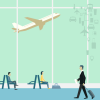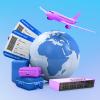Industry
The status quo is changing for most industries as boundaries blur between fields due to innovation, disruption, and digitally-driven change. That’s why keeping abreast of emerging trends in sectors outside your own is vital, not only because your organization’s competitive landscape may be changing, but because there are universal, strategic lessons to learn from the opportunities and threats convergence poses for every marketplace. We examine emerging trends and the impact of evolving tech in key fields such as healthcare, financial services, telco, energy, mobility, and more to help you capitalize on the possibilities of the future while managing the challenges of today.
Insight
Technological and economic developments are accelerating the exploration of the cosmos and leading to the formation of a next-generation space economy that promises to significantly impact life on Earth and in outer space. This Amplify Update examines commercial developments in conjunction with key trends in emerging technologies and how they are helping to accelerate space exploration.
Repeated Amplify contributor Ralph Menzano posits that airports can be viewed as microcosms of cities and, as such, offer important lessons to public sector entities around the world. Specifically, emulating the strategies used by airports during the pandemic could help municipalities and others become more resilient. Airport leaders moved quickly to shut down terminals and gates, adjust flight schedules and staffing, and change parking systems — then pivoted to delivering vaccines and medical supplies rather than passengers. Leaders also made sure they were ready to resume expansion plans and hit revised passenger targets as soon as restrictions eased. Menzano points to strategies and technologies other public sector entities could benefit from, including sustainable programs (airports are adopting electric vehicles to transport passengers and luggage and deploying goat herds to maintain dense scrub vegetation), virtual assistants to help customers navigate complex websites, and personnel programs that simultaneously promote equity and diversity.
A group of authors from the National Renewable Energy Laboratory presents a roadmap for creating a more sustainable aviation ecosystem. The authors first explain the interdependencies in the ecosystem, including between infrastructure, communications and technology, energy justice, energy solutions, human systems, and transportation networks. They then look at solutions such as sustainable aviation fuel, hydrogen-based fuels, and electric propulsion systems. The authors conclude by describing the benefits of taking a holistic approach in which industry, federal, and state entities collaborate to help the aviation industry reach its decarbonization goal.
Fabian Steinmann offers concrete suggestions for improving the air transport industry’s resilience. Steinmann says to achieve resilience in operations, air transport operations should simultaneously upgrade system design, system preparedness, system response, and system change. System-design improvements include increasing capacity buffers, so a single runway disruption doesn’t ripple through a network, as has been the case in the UK. System preparedness involves deploying additional resources in the case of large events or strikes, proactively reducing flights before large storms, and improving connections between air transport companies and weather forecast providers. System change requires reviewing lessons learned from disruptions while considering proactive measures — always remembering that improvements in one area of the network may cause issues in other areas.
David Hart and Andrew Cunningham address economic-regulation risks. The authors delve into the distinct approaches recently taken by the UK Civil Aviation Authority (CAA) and the Irish Aviation Authority (IAA). CAA allocated an additional amount of money that airlines would pay back over a long period to offset the economic damage from the pandemic to Heathrow Airport Limited. IAA reacted in real time, suspending many regulations at Dublin Airport and ensuring monetary support would be forthcoming from the national government. Both airports have recovered well from the pandemic-caused downturn, and the authors say one’s view of the pandemic (was it a one-off? a predictor of large future shocks?) affects any final conclusion on which approach was the right one.
Despite worker shortages, high fuel costs, airfare increases, and sustained schedule disruptions, air travel demand is returning to pre-pandemic levels, and the industry is returning to a state of profitability. However, a return to profitability will not protect the industry from the next disruptive event. Instead, implementing integrated resilience measures across the aviation ecosystem will be critical to ensuring long-term economic viability. Emerging technologies, regulations, and changes in demand can serve as cornerstones, putting pressure on industry players to become active participants in creating a more integrated operating model. This issue of Amplify explores the first steps being taken by various aviation industry players. Their efforts are laying the groundwork for future attempts to deliver a more efficient, resilient, adaptable, and sustainable industry.
Cutter Expert Curt Hall looks at how artificial intelligence (AI), cloud computing, big data, machine learning (ML), computer vision, and Internet of Things (IoT) are being leveraged to combat disruptive forces such as pandemic-caused economic uncertainty, growing public awareness of climate change, and rising fuel prices. Hall describes which airlines are using which technologies for what purpose, such as shifting to cloud applications to help them scale and deploying AI to increase fuel efficiency and solve crew-staffing problems. Predictive analytics are helping airlines with weather forecasts, flight operations (reducing speed or altitude to lower fuel costs), and aircraft selection. On the ground, a combination of AI, IoT, and ML is reducing turnaround times, streamlining gate assignments to reduce taxi times, and even reducing food waste.
Maik Dehnert warns that banking’s current heuristic approach to digitization will not be successful. He offers a systems engineering approach as an alternative, in which analysis, followed by synthesis, realization, execution, and evaluation, are used to transform banking organizations.




























